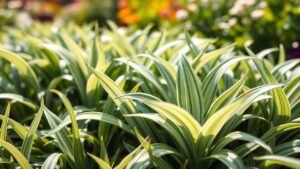Why Vibrant Leaves Are the Secret to a Thriving Plant
The lush, vibrant leaves of a houseplant are more than just decorative; they are the primary indicators of its overall health and the engine driving its survival. When you see brilliant green foliage, you are looking at a plant that is successfully performing its most critical life functions. Healthy leaves are the solar panels and lungs of the plant world, and understanding their role is the first step toward becoming a more intuitive and successful plant parent. Any disruption in a plant’s environment—whether from improper light, water, or nutrients—will often manifest first as a change in the foliage, offering you a direct and honest assessment of its well-being.
The Science of Green: Photosynthesis in Action
The brilliant green color of healthy leaves comes from a pigment called chlorophyll. This molecule is the powerhouse of the plant, responsible for one of the most essential processes on Earth: photosynthesis. During photosynthesis, chlorophyll captures energy from sunlight and uses it to convert water and carbon dioxide into glucose (sugar). This sugar is the plant’s food, providing the chemical energy needed to fuel everything from root development to new growth and flower production. According to the Royal Horticultural Society, this process not only feeds the plant but also releases the oxygen we breathe, making healthy foliage critical for the planet itself.
Beyond creating food, leaves also manage the plant’s water supply through a process called transpiration. Tiny pores on the leaf surface, known as stomata, open to release water vapor. This action creates a suction-like force that pulls water and essential nutrients from the soil up through the roots and stems. A plant with strong, healthy foliage is therefore more efficient at hydrating and nourishing itself, making it more resilient against pests, diseases, and environmental stress. When leaves are compromised, these fundamental systems break down, quickly leading to a decline in the plant’s overall health.
What Discolored Leaves Are Telling You
Since leaves are such clear indicators of health, their color can tell you a detailed story about what your plant needs. Paying attention to these signals allows you to diagnose and address problems before they become severe. According to the University of Minnesota Extension, specific color changes often point to distinct environmental issues.
- Yellow Leaves (Chlorosis): This is one of the most common issues. If older, lower leaves are turning yellow, it often indicates overwatering, which suffocates the roots. If new leaves are yellow, it might signal underwatering or a nutrient deficiency, particularly nitrogen.
- Brown, Crispy Tips or Edges: This is typically a sign of low humidity or inconsistent watering. The air may be too dry, or the plant may be drying out completely between waterings, causing the leaf tissue at the extremities to die. It can also be caused by a buildup of salts and minerals from tap water.
- Pale or Washed-Out Green Leaves: Foliage that looks faded or bleached is often receiving too much direct sunlight. The intense light can break down chlorophyll faster than the plant can produce it, leading to a “sunburned” appearance.
- Brown or Black Spots: These spots can be a red flag for fungal or bacterial infections, which often thrive in overly moist conditions. It’s crucial to isolate the affected plant to prevent the disease from spreading.
Pests and Diseases: Threats to Healthy Foliage
Even with perfect watering and light, leaves can still suffer from attacks by pests and diseases. These issues can cause physical damage, drain the plant of vital nutrients, and introduce harmful pathogens. Identifying these problems early is key to saving your plant. Common culprits often leave behind telltale signs on the foliage.
According to The Old Farmer’s Almanac, many common houseplant pests are tiny and difficult to spot until the damage is noticeable. Spider mites, for instance, create fine webbing on the undersides of leaves and cause a stippled, discolored appearance. Aphids and mealybugs suck sap from the plant, leading to yellowing, distorted growth, and a sticky residue known as honeydew. Other problems, like fungal diseases, manifest as powdery mildew (a white, dusty coating) or dark spots. Regularly inspecting your plant’s leaves, including the undersides and stems, allows you to catch these intruders before they mount a full-scale invasion, giving you time to treat the issue with insecticidal soap or other appropriate remedies.
Actionable Tips for Lush, Green Foliage
Promoting and maintaining vibrant leaves is an ongoing process that revolves around providing a stable and appropriate environment. By mastering a few core principles of plant care, you can ensure your plants have the foundation they need to flourish. The key is consistency and understanding the specific needs of your plant variety.
The University of Florida, IFAS Extension, provides a comprehensive guide to basic houseplant care that directly supports leaf health. Here are the most critical factors to focus on:
- Proper Lighting: Most houseplants thrive in bright, indirect light. Research your specific plant’s needs to avoid the extremes of scorching direct sun or growth-stunting low light.
- Consistent Watering: Instead of watering on a strict schedule, check the soil. Most plants prefer for the top inch or two of soil to dry out before receiving a thorough watering until it drains from the bottom. This prevents both root rot and dehydration.
- Adequate Humidity: Many popular houseplants are native to tropical regions and crave higher humidity than the average home provides. Grouping plants together, using a pebble tray, or running a humidifier can prevent brown, crispy leaf tips.
- Appropriate Feeding: During the growing season (spring and summer), use a balanced liquid fertilizer diluted to half-strength every 4-6 weeks. This replenishes essential nutrients in the soil that support robust leaf growth. Avoid fertilizing in the winter when most plants are dormant.
By monitoring your plant’s leaves and responding to their signals with these fundamental care practices, you can cultivate a thriving indoor garden filled with the beautiful, vibrant foliage that signifies true plant health.





